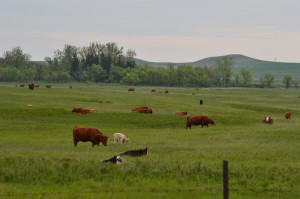We have much more to do and your continued support is needed now more than ever.
Having Lost Thousands of Cattle to the Blizzard, Northern Plains Ranchers Need a Farm Bill
The recent blizzard in western South Dakota didn’t just dump up to four feet of snow in the Black Hills, northwestern Nebraska and northeastern Wyoming. In killing thousands of cattle, it piled another hardship on ranchers, who in recent years have been losing ground, literally and figuratively, to row crop farming.
The disaster also added urgency to calls for Congress to pass the farm bill, which includes the disaster program that the ranchers need.
State officials estimate that after last weekend’s blizzard, 10,000-20,000 cattle were killed, a figure that amounts to about 5% of the state’s cattle herd. So many cattle died because they didn’t yet have their winter coats, and they were on summer pasture, where they didn’t have much shelter.
Because of the high cost for small- to mid-size size ranchers to buy insurance on their own, ranchers are looking to the federal government to help them recover from their losses.
The deadly blizzard came at a time when the ranching industry as a whole has been weakened.
- Last year brought a devastating drought that is continuing in parts of the southern Plains.
- As a result of high crop prices, ranchers have seen rising costs for both feed and land rents, which makes it harder for ranchers to compete with farmers for pasture.

Cattle grazing can be a sustainable use of grasslands, which evolved with grazing by ungulates like bison. But the same cannot be said of the croplands that replace grasslands. Compared to grasslands, annual crops like corn or beans leave the soil more exposed to erosion and provide precious little habitat for wildlife, like the waterfowl and grassland birds that nest in the Prairie Pothole Region.
The disaster assistance that ranchers need is in the expired farm bill. Livestock Indemnity Program (LIP) was included in the 2008 farm bill, but funding for it has expired with the lapsed farm bill. LIP covers up to 75% of fair market value of livestock killed directly by disasters such as blizzards. Producers don’t have to pay premiums but can receive up to $100,000 for their losses.
NWF’s Ag and Forestry team has been pushing for the farm bill to be reauthorized and for it to include a national Sodsaver provision and to link conservation compliance to crop insurance subsidies.
But until congress passes the farm bill, ranchers can only expect cold comfort from Washington.




















